Hospitality Provision in Travel and Tourism Sector: Analysis and Plan
VerifiedAdded on 2020/10/04
|16
|5389
|271
Report
AI Summary
This report delves into the hospitality sector's integral role within the broader travel and tourism industry. It begins by defining the hospitality sector and its various components, such as accommodation, restaurants, and travel services, and discusses its interrelationships with travel and tourism businesses. The report then analyzes the implications of integration within the hospitality industry, exploring both vertical and horizontal integration strategies and their effects on market share, branding, and cost reduction. A case study examines how integration has impacted a hospitality business. Finally, the report develops a rationale for a selected project, justifying decisions related to the target market and outlining a detailed business plan, including operational requirements and organizational structure with human resource allocation. This assignment provides a comprehensive overview of the hospitality sector's dynamics and strategic planning.
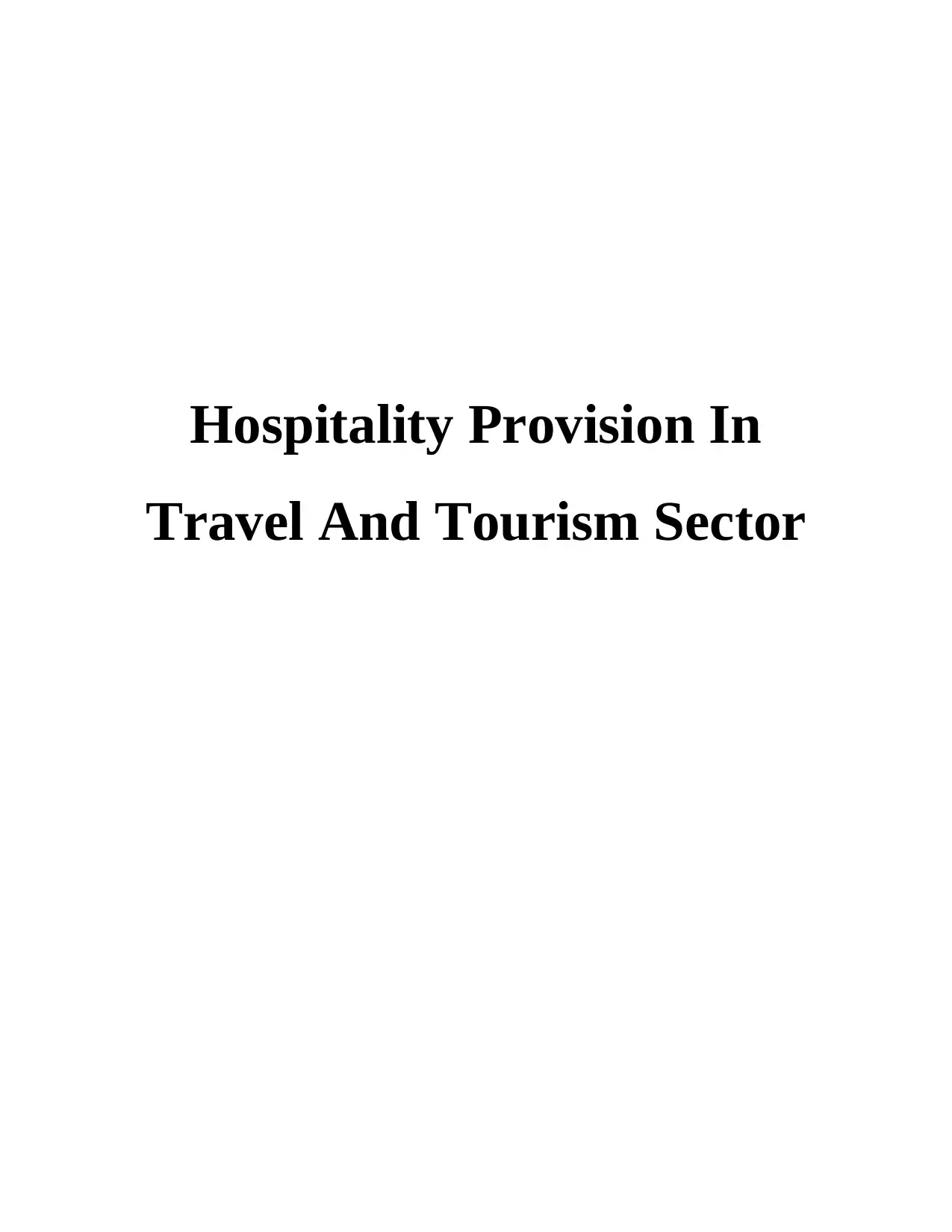
Hospitality Provision In
Travel And Tourism Sector
Travel And Tourism Sector
Paraphrase This Document
Need a fresh take? Get an instant paraphrase of this document with our AI Paraphraser
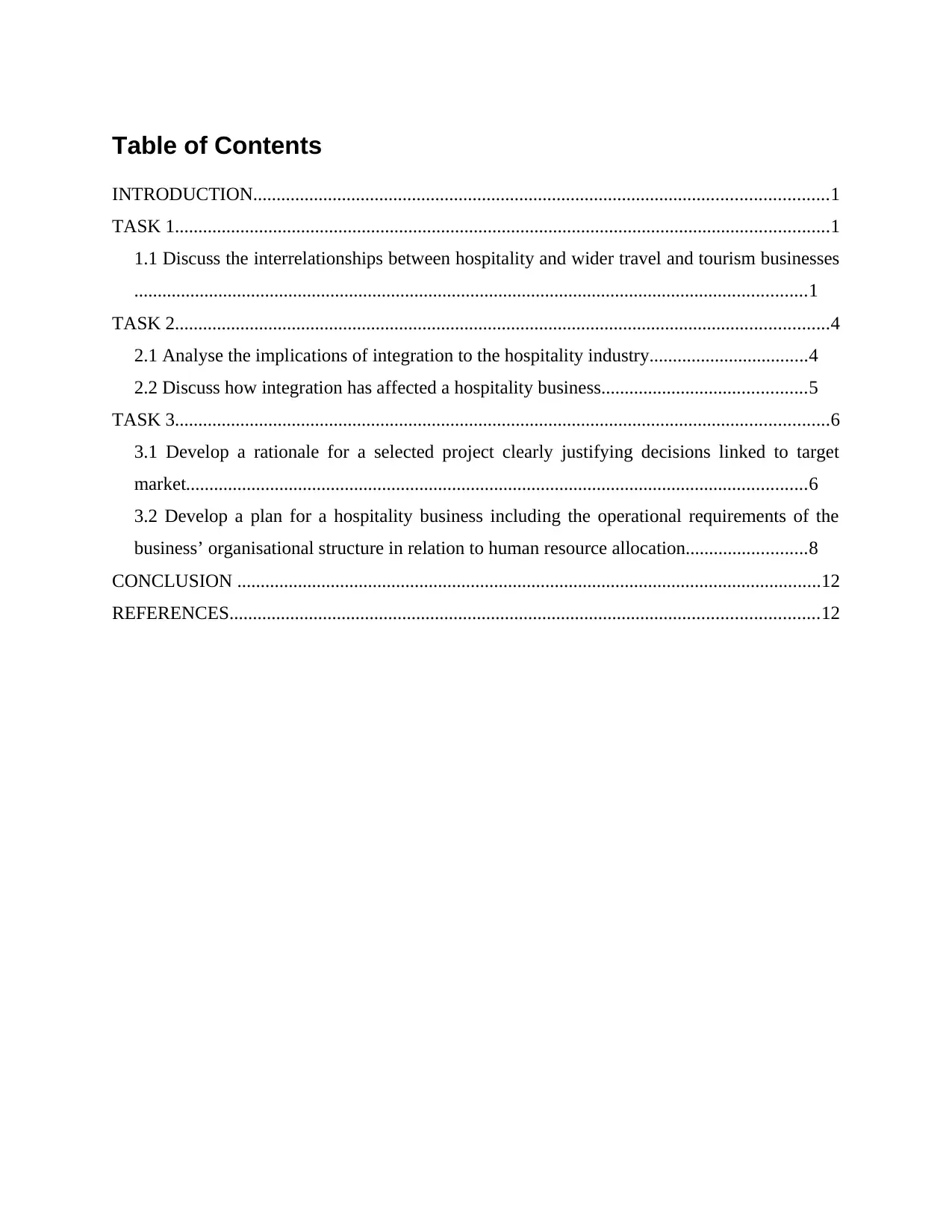
Table of Contents
INTRODUCTION...........................................................................................................................1
TASK 1............................................................................................................................................1
1.1 Discuss the interrelationships between hospitality and wider travel and tourism businesses
................................................................................................................................................1
TASK 2............................................................................................................................................4
2.1 Analyse the implications of integration to the hospitality industry..................................4
2.2 Discuss how integration has affected a hospitality business............................................5
TASK 3............................................................................................................................................6
3.1 Develop a rationale for a selected project clearly justifying decisions linked to target
market.....................................................................................................................................6
3.2 Develop a plan for a hospitality business including the operational requirements of the
business’ organisational structure in relation to human resource allocation..........................8
CONCLUSION .............................................................................................................................12
REFERENCES..............................................................................................................................12
INTRODUCTION...........................................................................................................................1
TASK 1............................................................................................................................................1
1.1 Discuss the interrelationships between hospitality and wider travel and tourism businesses
................................................................................................................................................1
TASK 2............................................................................................................................................4
2.1 Analyse the implications of integration to the hospitality industry..................................4
2.2 Discuss how integration has affected a hospitality business............................................5
TASK 3............................................................................................................................................6
3.1 Develop a rationale for a selected project clearly justifying decisions linked to target
market.....................................................................................................................................6
3.2 Develop a plan for a hospitality business including the operational requirements of the
business’ organisational structure in relation to human resource allocation..........................8
CONCLUSION .............................................................................................................................12
REFERENCES..............................................................................................................................12
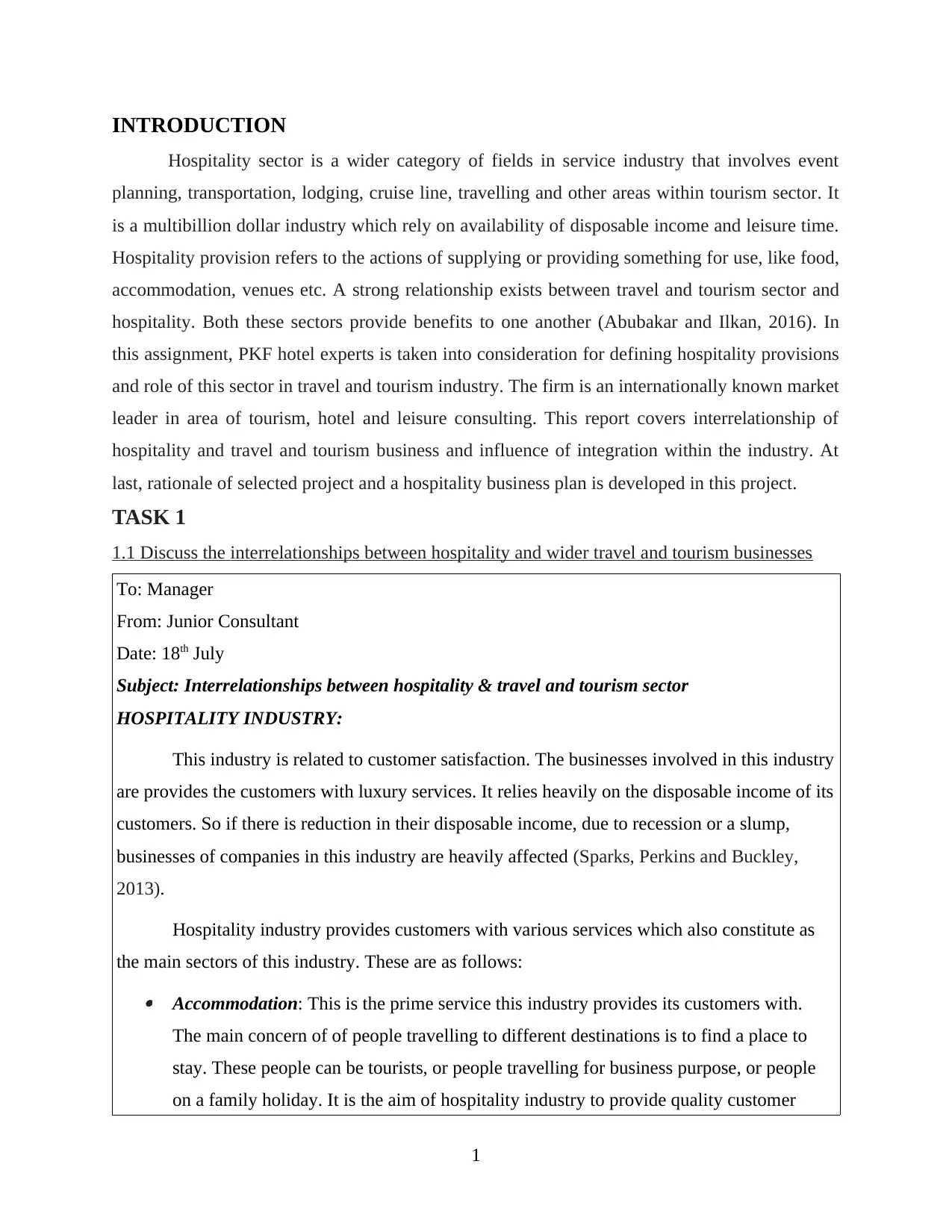
INTRODUCTION
Hospitality sector is a wider category of fields in service industry that involves event
planning, transportation, lodging, cruise line, travelling and other areas within tourism sector. It
is a multibillion dollar industry which rely on availability of disposable income and leisure time.
Hospitality provision refers to the actions of supplying or providing something for use, like food,
accommodation, venues etc. A strong relationship exists between travel and tourism sector and
hospitality. Both these sectors provide benefits to one another (Abubakar and Ilkan, 2016). In
this assignment, PKF hotel experts is taken into consideration for defining hospitality provisions
and role of this sector in travel and tourism industry. The firm is an internationally known market
leader in area of tourism, hotel and leisure consulting. This report covers interrelationship of
hospitality and travel and tourism business and influence of integration within the industry. At
last, rationale of selected project and a hospitality business plan is developed in this project.
TASK 1
1.1 Discuss the interrelationships between hospitality and wider travel and tourism businesses
To: Manager
From: Junior Consultant
Date: 18th July
Subject: Interrelationships between hospitality & travel and tourism sector
HOSPITALITY INDUSTRY:
This industry is related to customer satisfaction. The businesses involved in this industry
are provides the customers with luxury services. It relies heavily on the disposable income of its
customers. So if there is reduction in their disposable income, due to recession or a slump,
businesses of companies in this industry are heavily affected (Sparks, Perkins and Buckley,
2013).
Hospitality industry provides customers with various services which also constitute as
the main sectors of this industry. These are as follows: Accommodation: This is the prime service this industry provides its customers with.
The main concern of of people travelling to different destinations is to find a place to
stay. These people can be tourists, or people travelling for business purpose, or people
on a family holiday. It is the aim of hospitality industry to provide quality customer
1
Hospitality sector is a wider category of fields in service industry that involves event
planning, transportation, lodging, cruise line, travelling and other areas within tourism sector. It
is a multibillion dollar industry which rely on availability of disposable income and leisure time.
Hospitality provision refers to the actions of supplying or providing something for use, like food,
accommodation, venues etc. A strong relationship exists between travel and tourism sector and
hospitality. Both these sectors provide benefits to one another (Abubakar and Ilkan, 2016). In
this assignment, PKF hotel experts is taken into consideration for defining hospitality provisions
and role of this sector in travel and tourism industry. The firm is an internationally known market
leader in area of tourism, hotel and leisure consulting. This report covers interrelationship of
hospitality and travel and tourism business and influence of integration within the industry. At
last, rationale of selected project and a hospitality business plan is developed in this project.
TASK 1
1.1 Discuss the interrelationships between hospitality and wider travel and tourism businesses
To: Manager
From: Junior Consultant
Date: 18th July
Subject: Interrelationships between hospitality & travel and tourism sector
HOSPITALITY INDUSTRY:
This industry is related to customer satisfaction. The businesses involved in this industry
are provides the customers with luxury services. It relies heavily on the disposable income of its
customers. So if there is reduction in their disposable income, due to recession or a slump,
businesses of companies in this industry are heavily affected (Sparks, Perkins and Buckley,
2013).
Hospitality industry provides customers with various services which also constitute as
the main sectors of this industry. These are as follows: Accommodation: This is the prime service this industry provides its customers with.
The main concern of of people travelling to different destinations is to find a place to
stay. These people can be tourists, or people travelling for business purpose, or people
on a family holiday. It is the aim of hospitality industry to provide quality customer
1
⊘ This is a preview!⊘
Do you want full access?
Subscribe today to unlock all pages.

Trusted by 1+ million students worldwide
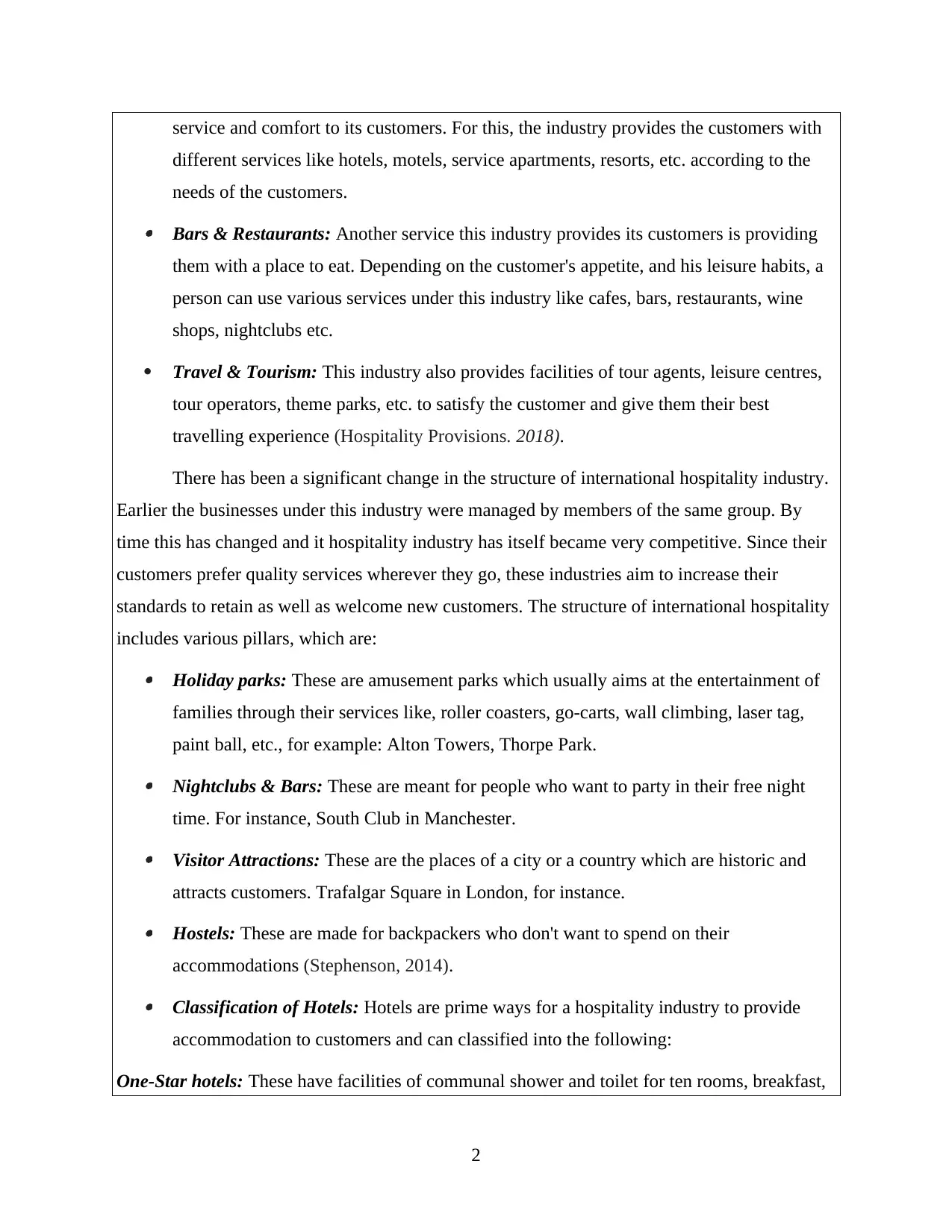
service and comfort to its customers. For this, the industry provides the customers with
different services like hotels, motels, service apartments, resorts, etc. according to the
needs of the customers. Bars & Restaurants: Another service this industry provides its customers is providing
them with a place to eat. Depending on the customer's appetite, and his leisure habits, a
person can use various services under this industry like cafes, bars, restaurants, wine
shops, nightclubs etc.
Travel & Tourism: This industry also provides facilities of tour agents, leisure centres,
tour operators, theme parks, etc. to satisfy the customer and give them their best
travelling experience (Hospitality Provisions. 2018).
There has been a significant change in the structure of international hospitality industry.
Earlier the businesses under this industry were managed by members of the same group. By
time this has changed and it hospitality industry has itself became very competitive. Since their
customers prefer quality services wherever they go, these industries aim to increase their
standards to retain as well as welcome new customers. The structure of international hospitality
includes various pillars, which are: Holiday parks: These are amusement parks which usually aims at the entertainment of
families through their services like, roller coasters, go-carts, wall climbing, laser tag,
paint ball, etc., for example: Alton Towers, Thorpe Park. Nightclubs & Bars: These are meant for people who want to party in their free night
time. For instance, South Club in Manchester. Visitor Attractions: These are the places of a city or a country which are historic and
attracts customers. Trafalgar Square in London, for instance. Hostels: These are made for backpackers who don't want to spend on their
accommodations (Stephenson, 2014). Classification of Hotels: Hotels are prime ways for a hospitality industry to provide
accommodation to customers and can classified into the following:
One-Star hotels: These have facilities of communal shower and toilet for ten rooms, breakfast,
2
different services like hotels, motels, service apartments, resorts, etc. according to the
needs of the customers. Bars & Restaurants: Another service this industry provides its customers is providing
them with a place to eat. Depending on the customer's appetite, and his leisure habits, a
person can use various services under this industry like cafes, bars, restaurants, wine
shops, nightclubs etc.
Travel & Tourism: This industry also provides facilities of tour agents, leisure centres,
tour operators, theme parks, etc. to satisfy the customer and give them their best
travelling experience (Hospitality Provisions. 2018).
There has been a significant change in the structure of international hospitality industry.
Earlier the businesses under this industry were managed by members of the same group. By
time this has changed and it hospitality industry has itself became very competitive. Since their
customers prefer quality services wherever they go, these industries aim to increase their
standards to retain as well as welcome new customers. The structure of international hospitality
includes various pillars, which are: Holiday parks: These are amusement parks which usually aims at the entertainment of
families through their services like, roller coasters, go-carts, wall climbing, laser tag,
paint ball, etc., for example: Alton Towers, Thorpe Park. Nightclubs & Bars: These are meant for people who want to party in their free night
time. For instance, South Club in Manchester. Visitor Attractions: These are the places of a city or a country which are historic and
attracts customers. Trafalgar Square in London, for instance. Hostels: These are made for backpackers who don't want to spend on their
accommodations (Stephenson, 2014). Classification of Hotels: Hotels are prime ways for a hospitality industry to provide
accommodation to customers and can classified into the following:
One-Star hotels: These have facilities of communal shower and toilet for ten rooms, breakfast,
2
Paraphrase This Document
Need a fresh take? Get an instant paraphrase of this document with our AI Paraphraser
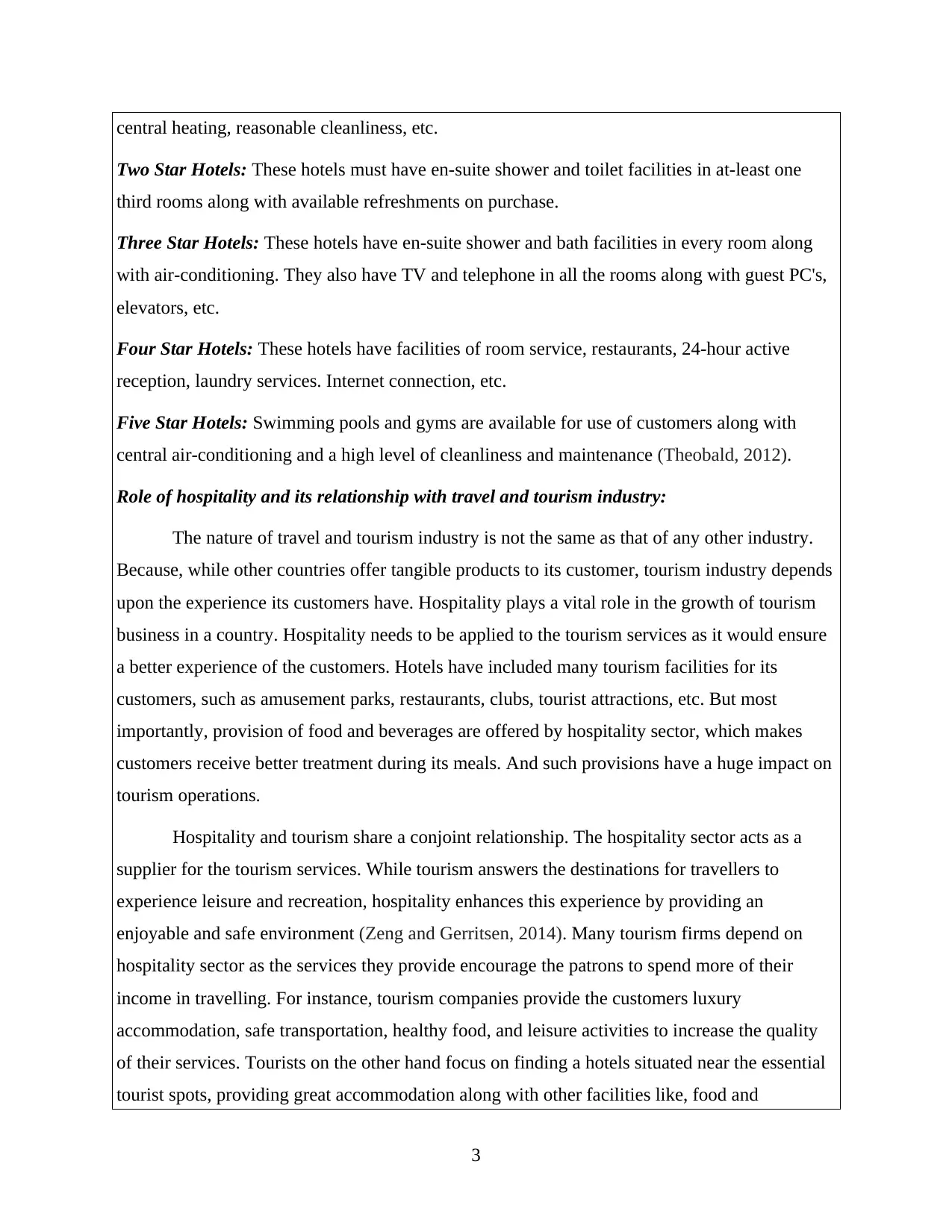
central heating, reasonable cleanliness, etc.
Two Star Hotels: These hotels must have en-suite shower and toilet facilities in at-least one
third rooms along with available refreshments on purchase.
Three Star Hotels: These hotels have en-suite shower and bath facilities in every room along
with air-conditioning. They also have TV and telephone in all the rooms along with guest PC's,
elevators, etc.
Four Star Hotels: These hotels have facilities of room service, restaurants, 24-hour active
reception, laundry services. Internet connection, etc.
Five Star Hotels: Swimming pools and gyms are available for use of customers along with
central air-conditioning and a high level of cleanliness and maintenance (Theobald, 2012).
Role of hospitality and its relationship with travel and tourism industry:
The nature of travel and tourism industry is not the same as that of any other industry.
Because, while other countries offer tangible products to its customer, tourism industry depends
upon the experience its customers have. Hospitality plays a vital role in the growth of tourism
business in a country. Hospitality needs to be applied to the tourism services as it would ensure
a better experience of the customers. Hotels have included many tourism facilities for its
customers, such as amusement parks, restaurants, clubs, tourist attractions, etc. But most
importantly, provision of food and beverages are offered by hospitality sector, which makes
customers receive better treatment during its meals. And such provisions have a huge impact on
tourism operations.
Hospitality and tourism share a conjoint relationship. The hospitality sector acts as a
supplier for the tourism services. While tourism answers the destinations for travellers to
experience leisure and recreation, hospitality enhances this experience by providing an
enjoyable and safe environment (Zeng and Gerritsen, 2014). Many tourism firms depend on
hospitality sector as the services they provide encourage the patrons to spend more of their
income in travelling. For instance, tourism companies provide the customers luxury
accommodation, safe transportation, healthy food, and leisure activities to increase the quality
of their services. Tourists on the other hand focus on finding a hotels situated near the essential
tourist spots, providing great accommodation along with other facilities like, food and
3
Two Star Hotels: These hotels must have en-suite shower and toilet facilities in at-least one
third rooms along with available refreshments on purchase.
Three Star Hotels: These hotels have en-suite shower and bath facilities in every room along
with air-conditioning. They also have TV and telephone in all the rooms along with guest PC's,
elevators, etc.
Four Star Hotels: These hotels have facilities of room service, restaurants, 24-hour active
reception, laundry services. Internet connection, etc.
Five Star Hotels: Swimming pools and gyms are available for use of customers along with
central air-conditioning and a high level of cleanliness and maintenance (Theobald, 2012).
Role of hospitality and its relationship with travel and tourism industry:
The nature of travel and tourism industry is not the same as that of any other industry.
Because, while other countries offer tangible products to its customer, tourism industry depends
upon the experience its customers have. Hospitality plays a vital role in the growth of tourism
business in a country. Hospitality needs to be applied to the tourism services as it would ensure
a better experience of the customers. Hotels have included many tourism facilities for its
customers, such as amusement parks, restaurants, clubs, tourist attractions, etc. But most
importantly, provision of food and beverages are offered by hospitality sector, which makes
customers receive better treatment during its meals. And such provisions have a huge impact on
tourism operations.
Hospitality and tourism share a conjoint relationship. The hospitality sector acts as a
supplier for the tourism services. While tourism answers the destinations for travellers to
experience leisure and recreation, hospitality enhances this experience by providing an
enjoyable and safe environment (Zeng and Gerritsen, 2014). Many tourism firms depend on
hospitality sector as the services they provide encourage the patrons to spend more of their
income in travelling. For instance, tourism companies provide the customers luxury
accommodation, safe transportation, healthy food, and leisure activities to increase the quality
of their services. Tourists on the other hand focus on finding a hotels situated near the essential
tourist spots, providing great accommodation along with other facilities like, food and
3
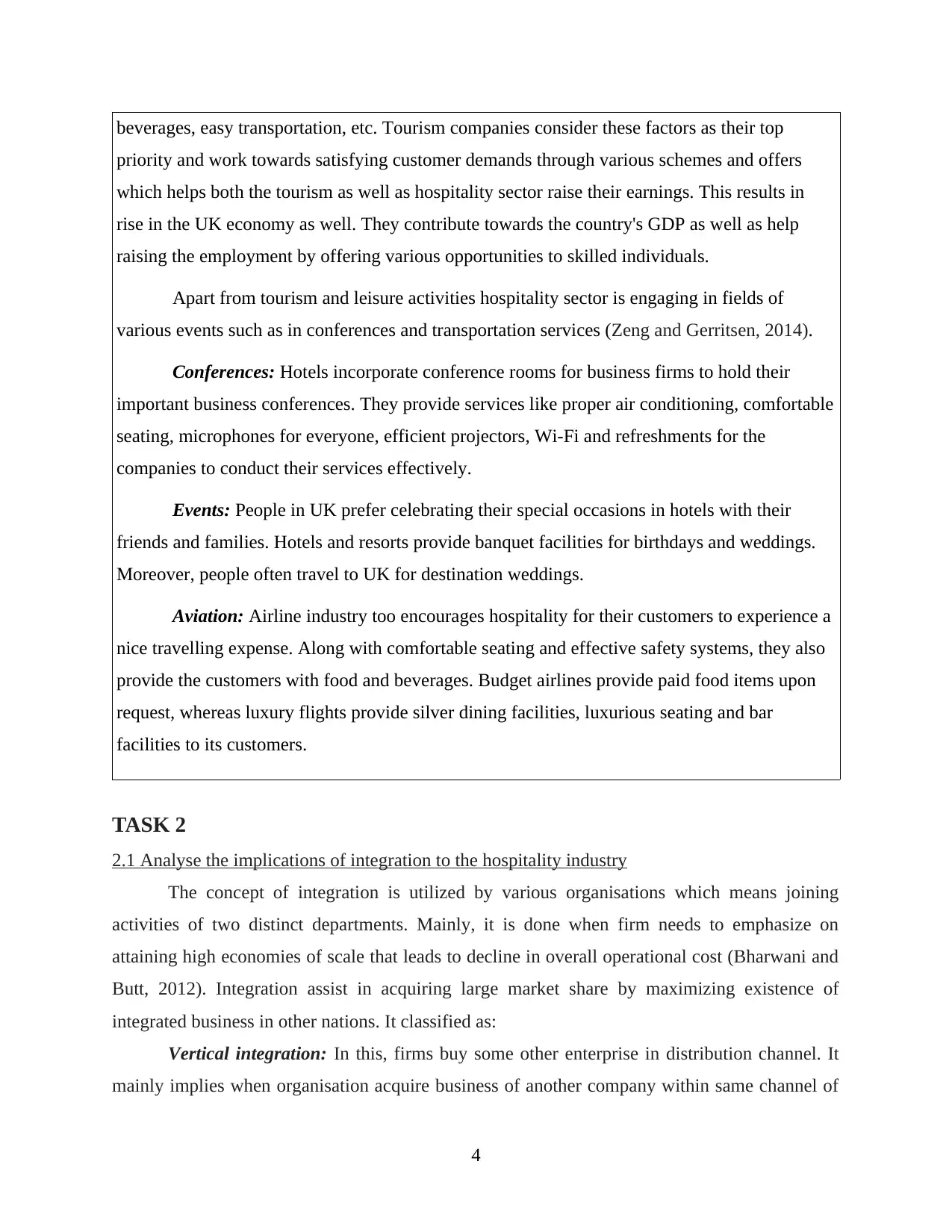
beverages, easy transportation, etc. Tourism companies consider these factors as their top
priority and work towards satisfying customer demands through various schemes and offers
which helps both the tourism as well as hospitality sector raise their earnings. This results in
rise in the UK economy as well. They contribute towards the country's GDP as well as help
raising the employment by offering various opportunities to skilled individuals.
Apart from tourism and leisure activities hospitality sector is engaging in fields of
various events such as in conferences and transportation services (Zeng and Gerritsen, 2014).
Conferences: Hotels incorporate conference rooms for business firms to hold their
important business conferences. They provide services like proper air conditioning, comfortable
seating, microphones for everyone, efficient projectors, Wi-Fi and refreshments for the
companies to conduct their services effectively.
Events: People in UK prefer celebrating their special occasions in hotels with their
friends and families. Hotels and resorts provide banquet facilities for birthdays and weddings.
Moreover, people often travel to UK for destination weddings.
Aviation: Airline industry too encourages hospitality for their customers to experience a
nice travelling expense. Along with comfortable seating and effective safety systems, they also
provide the customers with food and beverages. Budget airlines provide paid food items upon
request, whereas luxury flights provide silver dining facilities, luxurious seating and bar
facilities to its customers.
TASK 2
2.1 Analyse the implications of integration to the hospitality industry
The concept of integration is utilized by various organisations which means joining
activities of two distinct departments. Mainly, it is done when firm needs to emphasize on
attaining high economies of scale that leads to decline in overall operational cost (Bharwani and
Butt, 2012). Integration assist in acquiring large market share by maximizing existence of
integrated business in other nations. It classified as:
Vertical integration: In this, firms buy some other enterprise in distribution channel. It
mainly implies when organisation acquire business of another company within same channel of
4
priority and work towards satisfying customer demands through various schemes and offers
which helps both the tourism as well as hospitality sector raise their earnings. This results in
rise in the UK economy as well. They contribute towards the country's GDP as well as help
raising the employment by offering various opportunities to skilled individuals.
Apart from tourism and leisure activities hospitality sector is engaging in fields of
various events such as in conferences and transportation services (Zeng and Gerritsen, 2014).
Conferences: Hotels incorporate conference rooms for business firms to hold their
important business conferences. They provide services like proper air conditioning, comfortable
seating, microphones for everyone, efficient projectors, Wi-Fi and refreshments for the
companies to conduct their services effectively.
Events: People in UK prefer celebrating their special occasions in hotels with their
friends and families. Hotels and resorts provide banquet facilities for birthdays and weddings.
Moreover, people often travel to UK for destination weddings.
Aviation: Airline industry too encourages hospitality for their customers to experience a
nice travelling expense. Along with comfortable seating and effective safety systems, they also
provide the customers with food and beverages. Budget airlines provide paid food items upon
request, whereas luxury flights provide silver dining facilities, luxurious seating and bar
facilities to its customers.
TASK 2
2.1 Analyse the implications of integration to the hospitality industry
The concept of integration is utilized by various organisations which means joining
activities of two distinct departments. Mainly, it is done when firm needs to emphasize on
attaining high economies of scale that leads to decline in overall operational cost (Bharwani and
Butt, 2012). Integration assist in acquiring large market share by maximizing existence of
integrated business in other nations. It classified as:
Vertical integration: In this, firms buy some other enterprise in distribution channel. It
mainly implies when organisation acquire business of another company within same channel of
4
⊘ This is a preview!⊘
Do you want full access?
Subscribe today to unlock all pages.

Trusted by 1+ million students worldwide
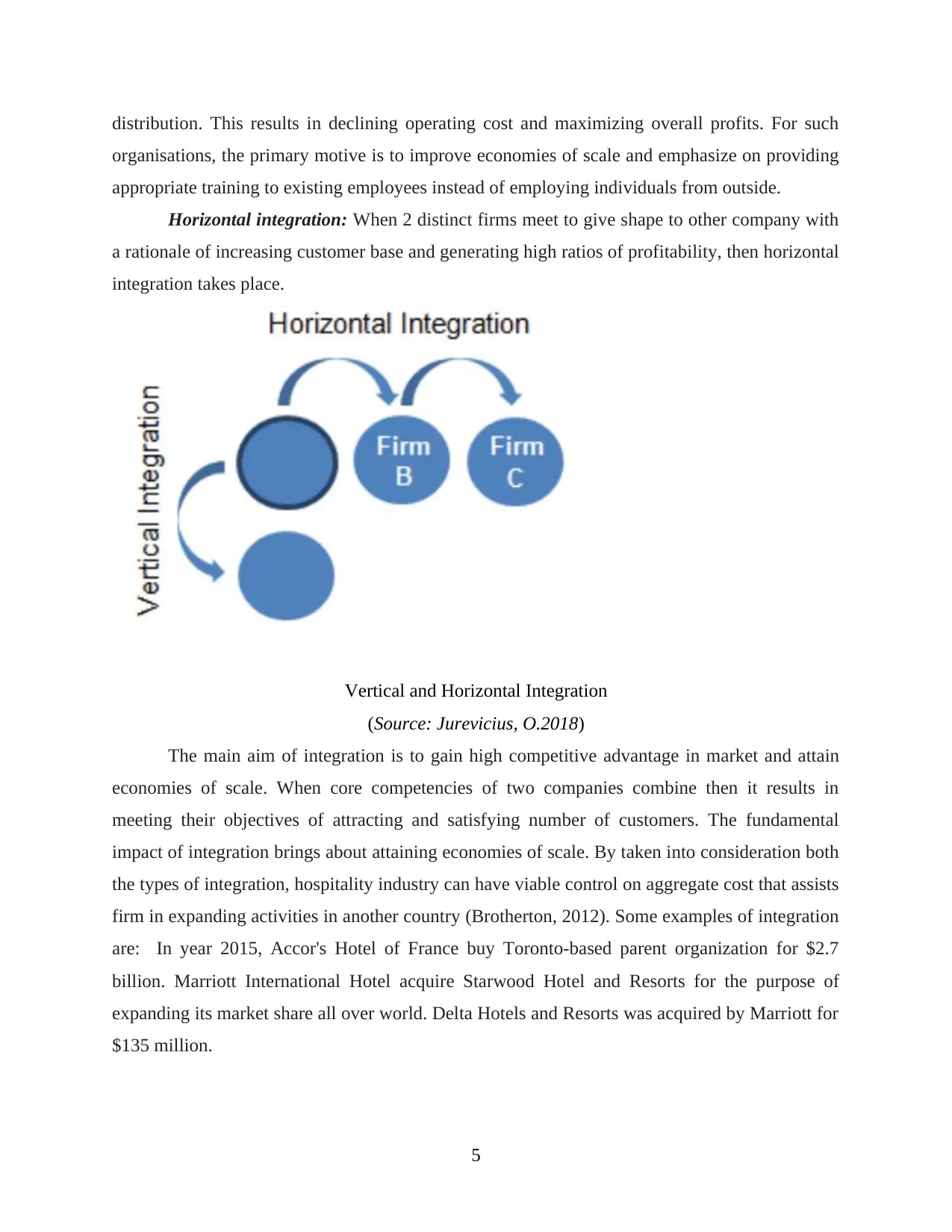
distribution. This results in declining operating cost and maximizing overall profits. For such
organisations, the primary motive is to improve economies of scale and emphasize on providing
appropriate training to existing employees instead of employing individuals from outside.
Horizontal integration: When 2 distinct firms meet to give shape to other company with
a rationale of increasing customer base and generating high ratios of profitability, then horizontal
integration takes place.
Vertical and Horizontal Integration
(Source: Jurevicius, O.2018)
The main aim of integration is to gain high competitive advantage in market and attain
economies of scale. When core competencies of two companies combine then it results in
meeting their objectives of attracting and satisfying number of customers. The fundamental
impact of integration brings about attaining economies of scale. By taken into consideration both
the types of integration, hospitality industry can have viable control on aggregate cost that assists
firm in expanding activities in another country (Brotherton, 2012). Some examples of integration
are: In year 2015, Accor's Hotel of France buy Toronto-based parent organization for $2.7
billion. Marriott International Hotel acquire Starwood Hotel and Resorts for the purpose of
expanding its market share all over world. Delta Hotels and Resorts was acquired by Marriott for
$135 million.
5
organisations, the primary motive is to improve economies of scale and emphasize on providing
appropriate training to existing employees instead of employing individuals from outside.
Horizontal integration: When 2 distinct firms meet to give shape to other company with
a rationale of increasing customer base and generating high ratios of profitability, then horizontal
integration takes place.
Vertical and Horizontal Integration
(Source: Jurevicius, O.2018)
The main aim of integration is to gain high competitive advantage in market and attain
economies of scale. When core competencies of two companies combine then it results in
meeting their objectives of attracting and satisfying number of customers. The fundamental
impact of integration brings about attaining economies of scale. By taken into consideration both
the types of integration, hospitality industry can have viable control on aggregate cost that assists
firm in expanding activities in another country (Brotherton, 2012). Some examples of integration
are: In year 2015, Accor's Hotel of France buy Toronto-based parent organization for $2.7
billion. Marriott International Hotel acquire Starwood Hotel and Resorts for the purpose of
expanding its market share all over world. Delta Hotels and Resorts was acquired by Marriott for
$135 million.
5
Paraphrase This Document
Need a fresh take? Get an instant paraphrase of this document with our AI Paraphraser
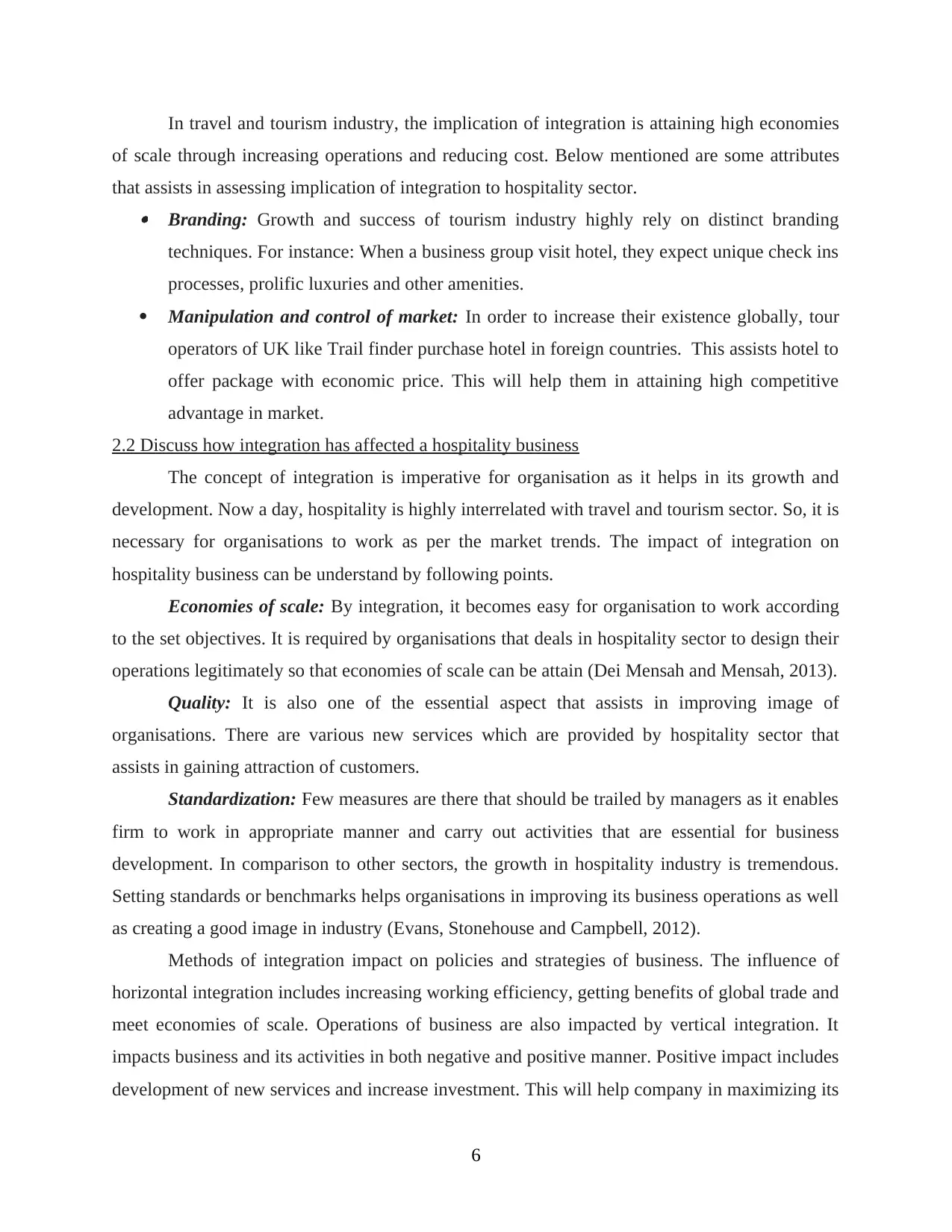
In travel and tourism industry, the implication of integration is attaining high economies
of scale through increasing operations and reducing cost. Below mentioned are some attributes
that assists in assessing implication of integration to hospitality sector. Branding: Growth and success of tourism industry highly rely on distinct branding
techniques. For instance: When a business group visit hotel, they expect unique check ins
processes, prolific luxuries and other amenities.
Manipulation and control of market: In order to increase their existence globally, tour
operators of UK like Trail finder purchase hotel in foreign countries. This assists hotel to
offer package with economic price. This will help them in attaining high competitive
advantage in market.
2.2 Discuss how integration has affected a hospitality business
The concept of integration is imperative for organisation as it helps in its growth and
development. Now a day, hospitality is highly interrelated with travel and tourism sector. So, it is
necessary for organisations to work as per the market trends. The impact of integration on
hospitality business can be understand by following points.
Economies of scale: By integration, it becomes easy for organisation to work according
to the set objectives. It is required by organisations that deals in hospitality sector to design their
operations legitimately so that economies of scale can be attain (Dei Mensah and Mensah, 2013).
Quality: It is also one of the essential aspect that assists in improving image of
organisations. There are various new services which are provided by hospitality sector that
assists in gaining attraction of customers.
Standardization: Few measures are there that should be trailed by managers as it enables
firm to work in appropriate manner and carry out activities that are essential for business
development. In comparison to other sectors, the growth in hospitality industry is tremendous.
Setting standards or benchmarks helps organisations in improving its business operations as well
as creating a good image in industry (Evans, Stonehouse and Campbell, 2012).
Methods of integration impact on policies and strategies of business. The influence of
horizontal integration includes increasing working efficiency, getting benefits of global trade and
meet economies of scale. Operations of business are also impacted by vertical integration. It
impacts business and its activities in both negative and positive manner. Positive impact includes
development of new services and increase investment. This will help company in maximizing its
6
of scale through increasing operations and reducing cost. Below mentioned are some attributes
that assists in assessing implication of integration to hospitality sector. Branding: Growth and success of tourism industry highly rely on distinct branding
techniques. For instance: When a business group visit hotel, they expect unique check ins
processes, prolific luxuries and other amenities.
Manipulation and control of market: In order to increase their existence globally, tour
operators of UK like Trail finder purchase hotel in foreign countries. This assists hotel to
offer package with economic price. This will help them in attaining high competitive
advantage in market.
2.2 Discuss how integration has affected a hospitality business
The concept of integration is imperative for organisation as it helps in its growth and
development. Now a day, hospitality is highly interrelated with travel and tourism sector. So, it is
necessary for organisations to work as per the market trends. The impact of integration on
hospitality business can be understand by following points.
Economies of scale: By integration, it becomes easy for organisation to work according
to the set objectives. It is required by organisations that deals in hospitality sector to design their
operations legitimately so that economies of scale can be attain (Dei Mensah and Mensah, 2013).
Quality: It is also one of the essential aspect that assists in improving image of
organisations. There are various new services which are provided by hospitality sector that
assists in gaining attraction of customers.
Standardization: Few measures are there that should be trailed by managers as it enables
firm to work in appropriate manner and carry out activities that are essential for business
development. In comparison to other sectors, the growth in hospitality industry is tremendous.
Setting standards or benchmarks helps organisations in improving its business operations as well
as creating a good image in industry (Evans, Stonehouse and Campbell, 2012).
Methods of integration impact on policies and strategies of business. The influence of
horizontal integration includes increasing working efficiency, getting benefits of global trade and
meet economies of scale. Operations of business are also impacted by vertical integration. It
impacts business and its activities in both negative and positive manner. Positive impact includes
development of new services and increase investment. This will help company in maximizing its
6
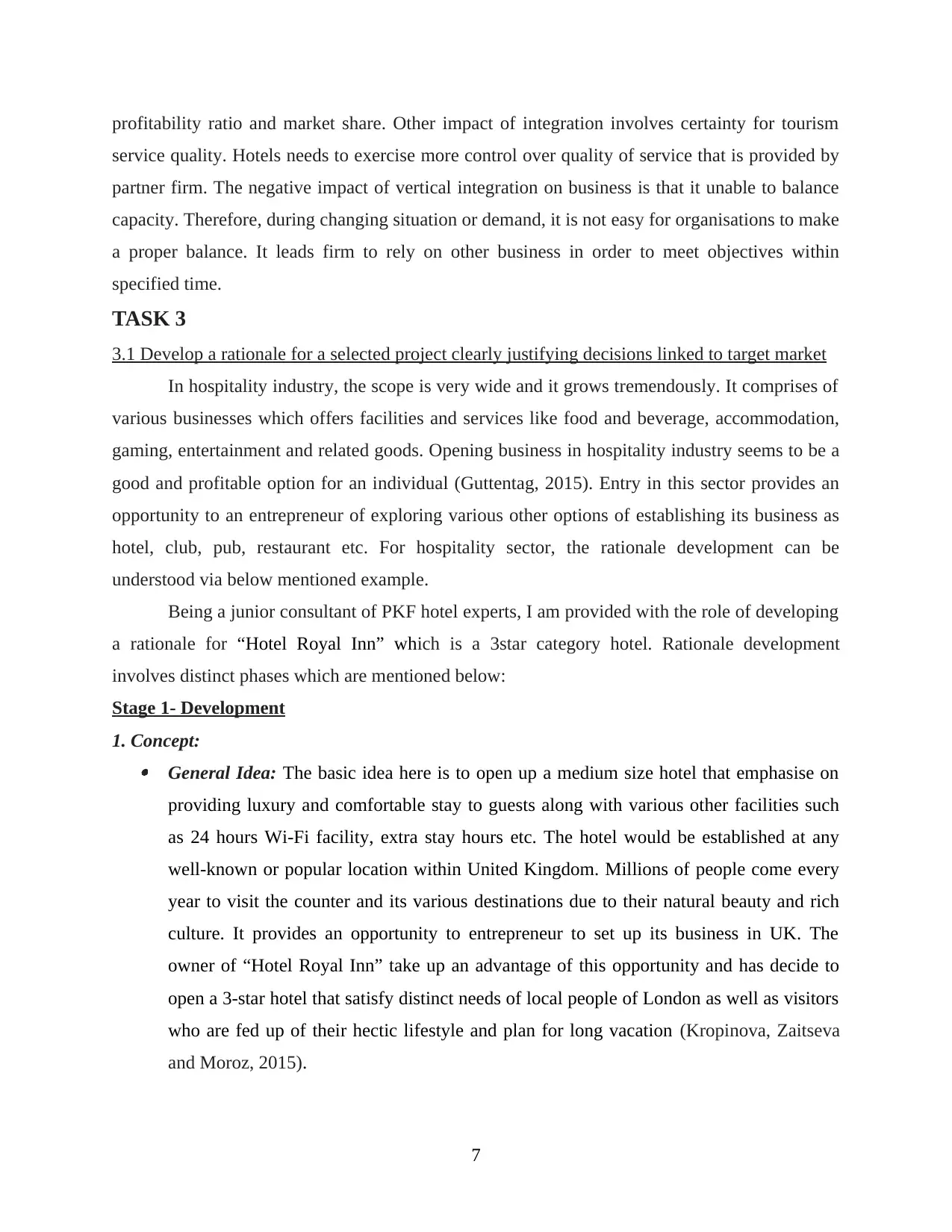
profitability ratio and market share. Other impact of integration involves certainty for tourism
service quality. Hotels needs to exercise more control over quality of service that is provided by
partner firm. The negative impact of vertical integration on business is that it unable to balance
capacity. Therefore, during changing situation or demand, it is not easy for organisations to make
a proper balance. It leads firm to rely on other business in order to meet objectives within
specified time.
TASK 3
3.1 Develop a rationale for a selected project clearly justifying decisions linked to target market
In hospitality industry, the scope is very wide and it grows tremendously. It comprises of
various businesses which offers facilities and services like food and beverage, accommodation,
gaming, entertainment and related goods. Opening business in hospitality industry seems to be a
good and profitable option for an individual (Guttentag, 2015). Entry in this sector provides an
opportunity to an entrepreneur of exploring various other options of establishing its business as
hotel, club, pub, restaurant etc. For hospitality sector, the rationale development can be
understood via below mentioned example.
Being a junior consultant of PKF hotel experts, I am provided with the role of developing
a rationale for “Hotel Royal Inn” which is a 3star category hotel. Rationale development
involves distinct phases which are mentioned below:
Stage 1- Development
1. Concept: General Idea: The basic idea here is to open up a medium size hotel that emphasise on
providing luxury and comfortable stay to guests along with various other facilities such
as 24 hours Wi-Fi facility, extra stay hours etc. The hotel would be established at any
well-known or popular location within United Kingdom. Millions of people come every
year to visit the counter and its various destinations due to their natural beauty and rich
culture. It provides an opportunity to entrepreneur to set up its business in UK. The
owner of “Hotel Royal Inn” take up an advantage of this opportunity and has decide to
open a 3-star hotel that satisfy distinct needs of local people of London as well as visitors
who are fed up of their hectic lifestyle and plan for long vacation (Kropinova, Zaitseva
and Moroz, 2015).
7
service quality. Hotels needs to exercise more control over quality of service that is provided by
partner firm. The negative impact of vertical integration on business is that it unable to balance
capacity. Therefore, during changing situation or demand, it is not easy for organisations to make
a proper balance. It leads firm to rely on other business in order to meet objectives within
specified time.
TASK 3
3.1 Develop a rationale for a selected project clearly justifying decisions linked to target market
In hospitality industry, the scope is very wide and it grows tremendously. It comprises of
various businesses which offers facilities and services like food and beverage, accommodation,
gaming, entertainment and related goods. Opening business in hospitality industry seems to be a
good and profitable option for an individual (Guttentag, 2015). Entry in this sector provides an
opportunity to an entrepreneur of exploring various other options of establishing its business as
hotel, club, pub, restaurant etc. For hospitality sector, the rationale development can be
understood via below mentioned example.
Being a junior consultant of PKF hotel experts, I am provided with the role of developing
a rationale for “Hotel Royal Inn” which is a 3star category hotel. Rationale development
involves distinct phases which are mentioned below:
Stage 1- Development
1. Concept: General Idea: The basic idea here is to open up a medium size hotel that emphasise on
providing luxury and comfortable stay to guests along with various other facilities such
as 24 hours Wi-Fi facility, extra stay hours etc. The hotel would be established at any
well-known or popular location within United Kingdom. Millions of people come every
year to visit the counter and its various destinations due to their natural beauty and rich
culture. It provides an opportunity to entrepreneur to set up its business in UK. The
owner of “Hotel Royal Inn” take up an advantage of this opportunity and has decide to
open a 3-star hotel that satisfy distinct needs of local people of London as well as visitors
who are fed up of their hectic lifestyle and plan for long vacation (Kropinova, Zaitseva
and Moroz, 2015).
7
⊘ This is a preview!⊘
Do you want full access?
Subscribe today to unlock all pages.

Trusted by 1+ million students worldwide
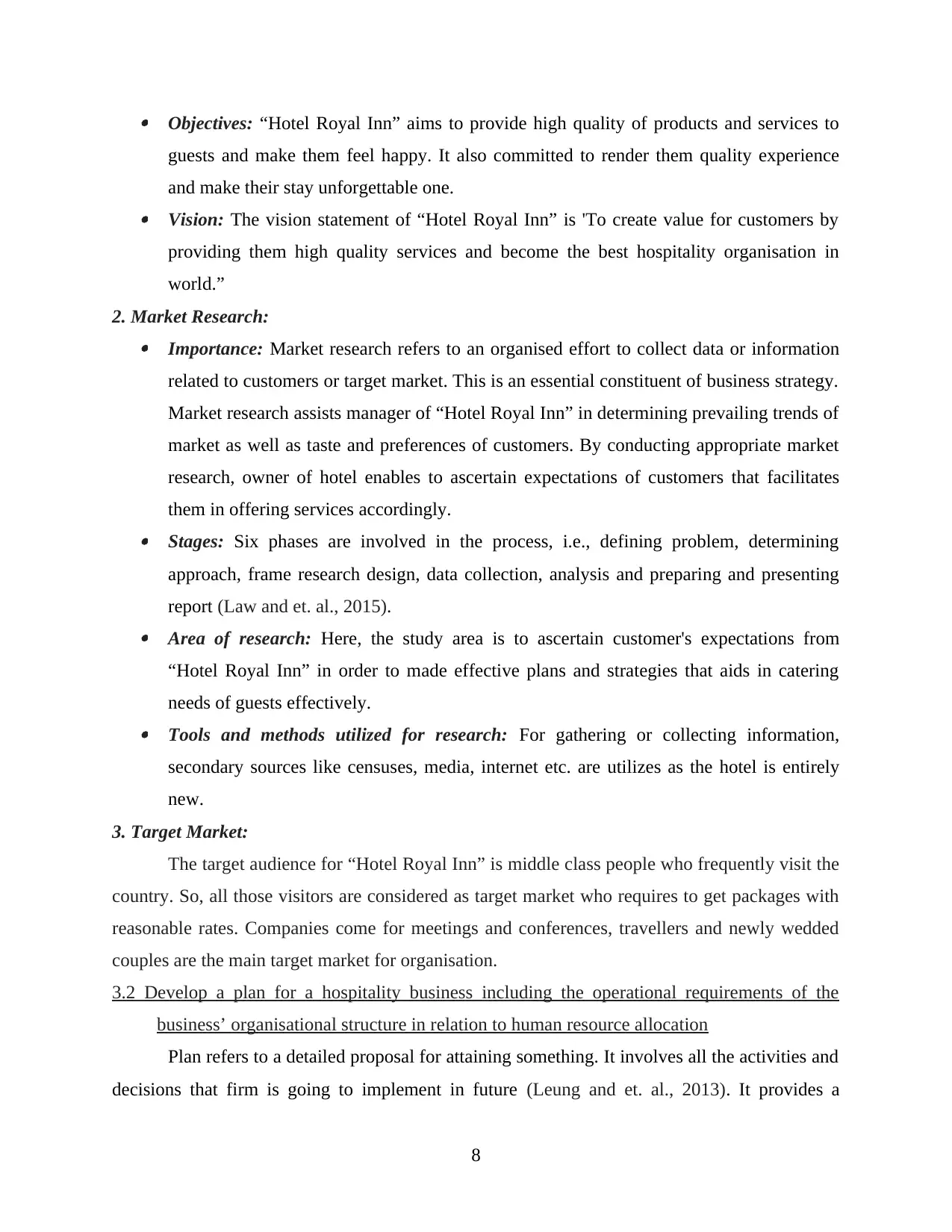
Objectives: “Hotel Royal Inn” aims to provide high quality of products and services to
guests and make them feel happy. It also committed to render them quality experience
and make their stay unforgettable one. Vision: The vision statement of “Hotel Royal Inn” is 'To create value for customers by
providing them high quality services and become the best hospitality organisation in
world.”
2. Market Research: Importance: Market research refers to an organised effort to collect data or information
related to customers or target market. This is an essential constituent of business strategy.
Market research assists manager of “Hotel Royal Inn” in determining prevailing trends of
market as well as taste and preferences of customers. By conducting appropriate market
research, owner of hotel enables to ascertain expectations of customers that facilitates
them in offering services accordingly. Stages: Six phases are involved in the process, i.e., defining problem, determining
approach, frame research design, data collection, analysis and preparing and presenting
report (Law and et. al., 2015). Area of research: Here, the study area is to ascertain customer's expectations from
“Hotel Royal Inn” in order to made effective plans and strategies that aids in catering
needs of guests effectively. Tools and methods utilized for research: For gathering or collecting information,
secondary sources like censuses, media, internet etc. are utilizes as the hotel is entirely
new.
3. Target Market:
The target audience for “Hotel Royal Inn” is middle class people who frequently visit the
country. So, all those visitors are considered as target market who requires to get packages with
reasonable rates. Companies come for meetings and conferences, travellers and newly wedded
couples are the main target market for organisation.
3.2 Develop a plan for a hospitality business including the operational requirements of the
business’ organisational structure in relation to human resource allocation
Plan refers to a detailed proposal for attaining something. It involves all the activities and
decisions that firm is going to implement in future (Leung and et. al., 2013). It provides a
8
guests and make them feel happy. It also committed to render them quality experience
and make their stay unforgettable one. Vision: The vision statement of “Hotel Royal Inn” is 'To create value for customers by
providing them high quality services and become the best hospitality organisation in
world.”
2. Market Research: Importance: Market research refers to an organised effort to collect data or information
related to customers or target market. This is an essential constituent of business strategy.
Market research assists manager of “Hotel Royal Inn” in determining prevailing trends of
market as well as taste and preferences of customers. By conducting appropriate market
research, owner of hotel enables to ascertain expectations of customers that facilitates
them in offering services accordingly. Stages: Six phases are involved in the process, i.e., defining problem, determining
approach, frame research design, data collection, analysis and preparing and presenting
report (Law and et. al., 2015). Area of research: Here, the study area is to ascertain customer's expectations from
“Hotel Royal Inn” in order to made effective plans and strategies that aids in catering
needs of guests effectively. Tools and methods utilized for research: For gathering or collecting information,
secondary sources like censuses, media, internet etc. are utilizes as the hotel is entirely
new.
3. Target Market:
The target audience for “Hotel Royal Inn” is middle class people who frequently visit the
country. So, all those visitors are considered as target market who requires to get packages with
reasonable rates. Companies come for meetings and conferences, travellers and newly wedded
couples are the main target market for organisation.
3.2 Develop a plan for a hospitality business including the operational requirements of the
business’ organisational structure in relation to human resource allocation
Plan refers to a detailed proposal for attaining something. It involves all the activities and
decisions that firm is going to implement in future (Leung and et. al., 2013). It provides a
8
Paraphrase This Document
Need a fresh take? Get an instant paraphrase of this document with our AI Paraphraser
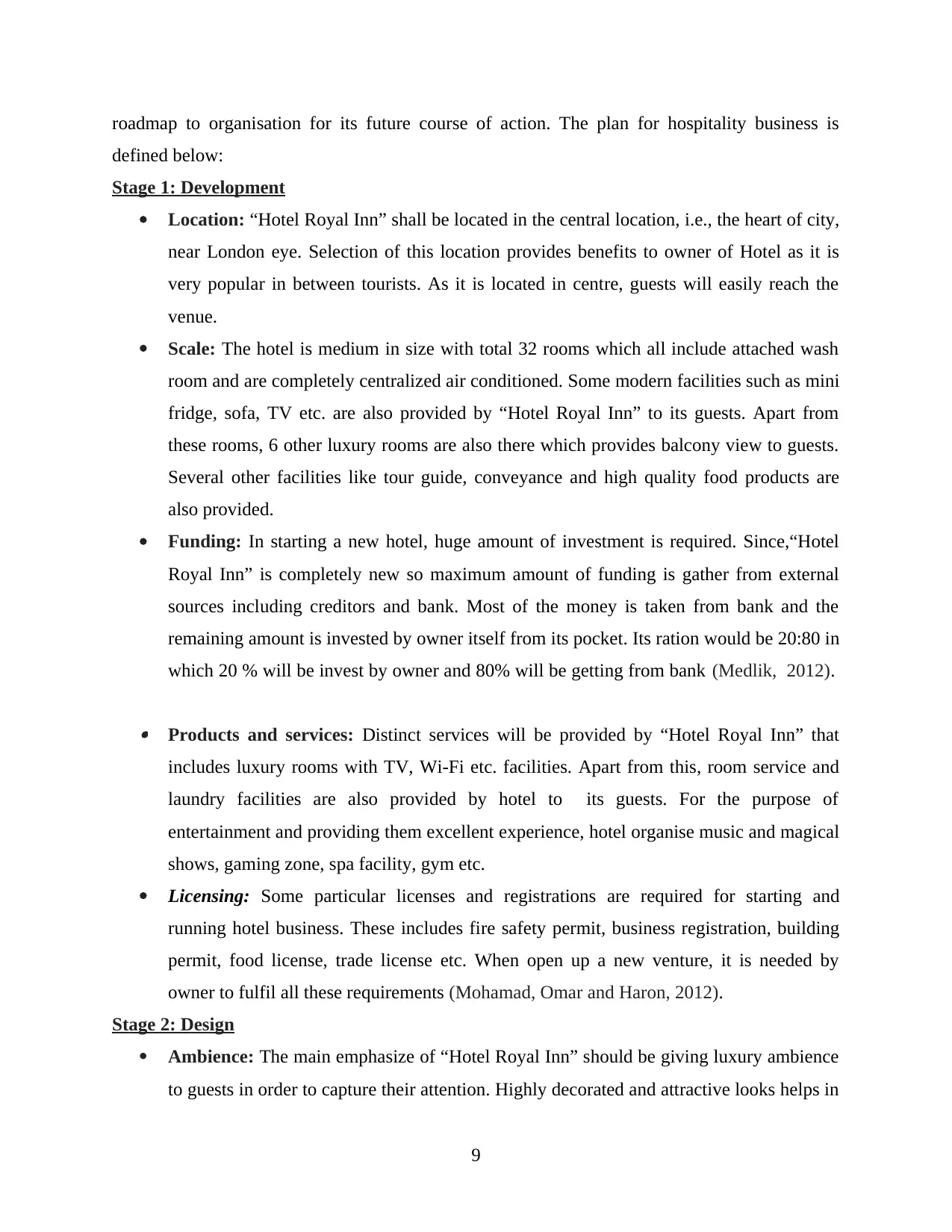
roadmap to organisation for its future course of action. The plan for hospitality business is
defined below:
Stage 1: Development
Location: “Hotel Royal Inn” shall be located in the central location, i.e., the heart of city,
near London eye. Selection of this location provides benefits to owner of Hotel as it is
very popular in between tourists. As it is located in centre, guests will easily reach the
venue.
Scale: The hotel is medium in size with total 32 rooms which all include attached wash
room and are completely centralized air conditioned. Some modern facilities such as mini
fridge, sofa, TV etc. are also provided by “Hotel Royal Inn” to its guests. Apart from
these rooms, 6 other luxury rooms are also there which provides balcony view to guests.
Several other facilities like tour guide, conveyance and high quality food products are
also provided.
Funding: In starting a new hotel, huge amount of investment is required. Since,“Hotel
Royal Inn” is completely new so maximum amount of funding is gather from external
sources including creditors and bank. Most of the money is taken from bank and the
remaining amount is invested by owner itself from its pocket. Its ration would be 20:80 in
which 20 % will be invest by owner and 80% will be getting from bank (Medlik, 2012).
Products and services: Distinct services will be provided by “Hotel Royal Inn” that
includes luxury rooms with TV, Wi-Fi etc. facilities. Apart from this, room service and
laundry facilities are also provided by hotel to its guests. For the purpose of
entertainment and providing them excellent experience, hotel organise music and magical
shows, gaming zone, spa facility, gym etc.
Licensing: Some particular licenses and registrations are required for starting and
running hotel business. These includes fire safety permit, business registration, building
permit, food license, trade license etc. When open up a new venture, it is needed by
owner to fulfil all these requirements (Mohamad, Omar and Haron, 2012).
Stage 2: Design
Ambience: The main emphasize of “Hotel Royal Inn” should be giving luxury ambience
to guests in order to capture their attention. Highly decorated and attractive looks helps in
9
defined below:
Stage 1: Development
Location: “Hotel Royal Inn” shall be located in the central location, i.e., the heart of city,
near London eye. Selection of this location provides benefits to owner of Hotel as it is
very popular in between tourists. As it is located in centre, guests will easily reach the
venue.
Scale: The hotel is medium in size with total 32 rooms which all include attached wash
room and are completely centralized air conditioned. Some modern facilities such as mini
fridge, sofa, TV etc. are also provided by “Hotel Royal Inn” to its guests. Apart from
these rooms, 6 other luxury rooms are also there which provides balcony view to guests.
Several other facilities like tour guide, conveyance and high quality food products are
also provided.
Funding: In starting a new hotel, huge amount of investment is required. Since,“Hotel
Royal Inn” is completely new so maximum amount of funding is gather from external
sources including creditors and bank. Most of the money is taken from bank and the
remaining amount is invested by owner itself from its pocket. Its ration would be 20:80 in
which 20 % will be invest by owner and 80% will be getting from bank (Medlik, 2012).
Products and services: Distinct services will be provided by “Hotel Royal Inn” that
includes luxury rooms with TV, Wi-Fi etc. facilities. Apart from this, room service and
laundry facilities are also provided by hotel to its guests. For the purpose of
entertainment and providing them excellent experience, hotel organise music and magical
shows, gaming zone, spa facility, gym etc.
Licensing: Some particular licenses and registrations are required for starting and
running hotel business. These includes fire safety permit, business registration, building
permit, food license, trade license etc. When open up a new venture, it is needed by
owner to fulfil all these requirements (Mohamad, Omar and Haron, 2012).
Stage 2: Design
Ambience: The main emphasize of “Hotel Royal Inn” should be giving luxury ambience
to guests in order to capture their attention. Highly decorated and attractive looks helps in
9
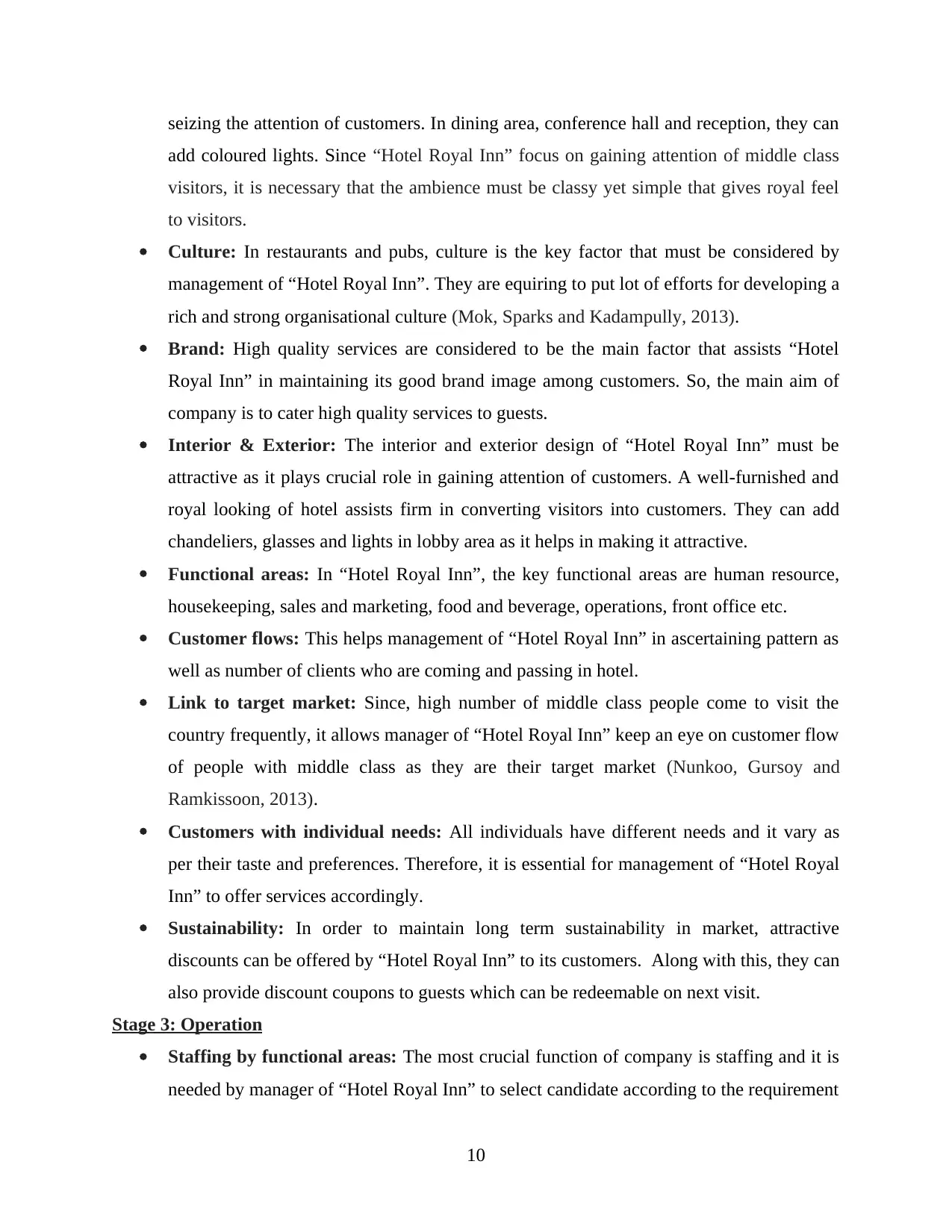
seizing the attention of customers. In dining area, conference hall and reception, they can
add coloured lights. Since “Hotel Royal Inn” focus on gaining attention of middle class
visitors, it is necessary that the ambience must be classy yet simple that gives royal feel
to visitors.
Culture: In restaurants and pubs, culture is the key factor that must be considered by
management of “Hotel Royal Inn”. They are equiring to put lot of efforts for developing a
rich and strong organisational culture (Mok, Sparks and Kadampully, 2013).
Brand: High quality services are considered to be the main factor that assists “Hotel
Royal Inn” in maintaining its good brand image among customers. So, the main aim of
company is to cater high quality services to guests.
Interior & Exterior: The interior and exterior design of “Hotel Royal Inn” must be
attractive as it plays crucial role in gaining attention of customers. A well-furnished and
royal looking of hotel assists firm in converting visitors into customers. They can add
chandeliers, glasses and lights in lobby area as it helps in making it attractive.
Functional areas: In “Hotel Royal Inn”, the key functional areas are human resource,
housekeeping, sales and marketing, food and beverage, operations, front office etc.
Customer flows: This helps management of “Hotel Royal Inn” in ascertaining pattern as
well as number of clients who are coming and passing in hotel.
Link to target market: Since, high number of middle class people come to visit the
country frequently, it allows manager of “Hotel Royal Inn” keep an eye on customer flow
of people with middle class as they are their target market (Nunkoo, Gursoy and
Ramkissoon, 2013).
Customers with individual needs: All individuals have different needs and it vary as
per their taste and preferences. Therefore, it is essential for management of “Hotel Royal
Inn” to offer services accordingly.
Sustainability: In order to maintain long term sustainability in market, attractive
discounts can be offered by “Hotel Royal Inn” to its customers. Along with this, they can
also provide discount coupons to guests which can be redeemable on next visit.
Stage 3: Operation
Staffing by functional areas: The most crucial function of company is staffing and it is
needed by manager of “Hotel Royal Inn” to select candidate according to the requirement
10
add coloured lights. Since “Hotel Royal Inn” focus on gaining attention of middle class
visitors, it is necessary that the ambience must be classy yet simple that gives royal feel
to visitors.
Culture: In restaurants and pubs, culture is the key factor that must be considered by
management of “Hotel Royal Inn”. They are equiring to put lot of efforts for developing a
rich and strong organisational culture (Mok, Sparks and Kadampully, 2013).
Brand: High quality services are considered to be the main factor that assists “Hotel
Royal Inn” in maintaining its good brand image among customers. So, the main aim of
company is to cater high quality services to guests.
Interior & Exterior: The interior and exterior design of “Hotel Royal Inn” must be
attractive as it plays crucial role in gaining attention of customers. A well-furnished and
royal looking of hotel assists firm in converting visitors into customers. They can add
chandeliers, glasses and lights in lobby area as it helps in making it attractive.
Functional areas: In “Hotel Royal Inn”, the key functional areas are human resource,
housekeeping, sales and marketing, food and beverage, operations, front office etc.
Customer flows: This helps management of “Hotel Royal Inn” in ascertaining pattern as
well as number of clients who are coming and passing in hotel.
Link to target market: Since, high number of middle class people come to visit the
country frequently, it allows manager of “Hotel Royal Inn” keep an eye on customer flow
of people with middle class as they are their target market (Nunkoo, Gursoy and
Ramkissoon, 2013).
Customers with individual needs: All individuals have different needs and it vary as
per their taste and preferences. Therefore, it is essential for management of “Hotel Royal
Inn” to offer services accordingly.
Sustainability: In order to maintain long term sustainability in market, attractive
discounts can be offered by “Hotel Royal Inn” to its customers. Along with this, they can
also provide discount coupons to guests which can be redeemable on next visit.
Stage 3: Operation
Staffing by functional areas: The most crucial function of company is staffing and it is
needed by manager of “Hotel Royal Inn” to select candidate according to the requirement
10
⊘ This is a preview!⊘
Do you want full access?
Subscribe today to unlock all pages.

Trusted by 1+ million students worldwide
1 out of 16
Related Documents
Your All-in-One AI-Powered Toolkit for Academic Success.
+13062052269
info@desklib.com
Available 24*7 on WhatsApp / Email
![[object Object]](/_next/static/media/star-bottom.7253800d.svg)
Unlock your academic potential
Copyright © 2020–2025 A2Z Services. All Rights Reserved. Developed and managed by ZUCOL.




